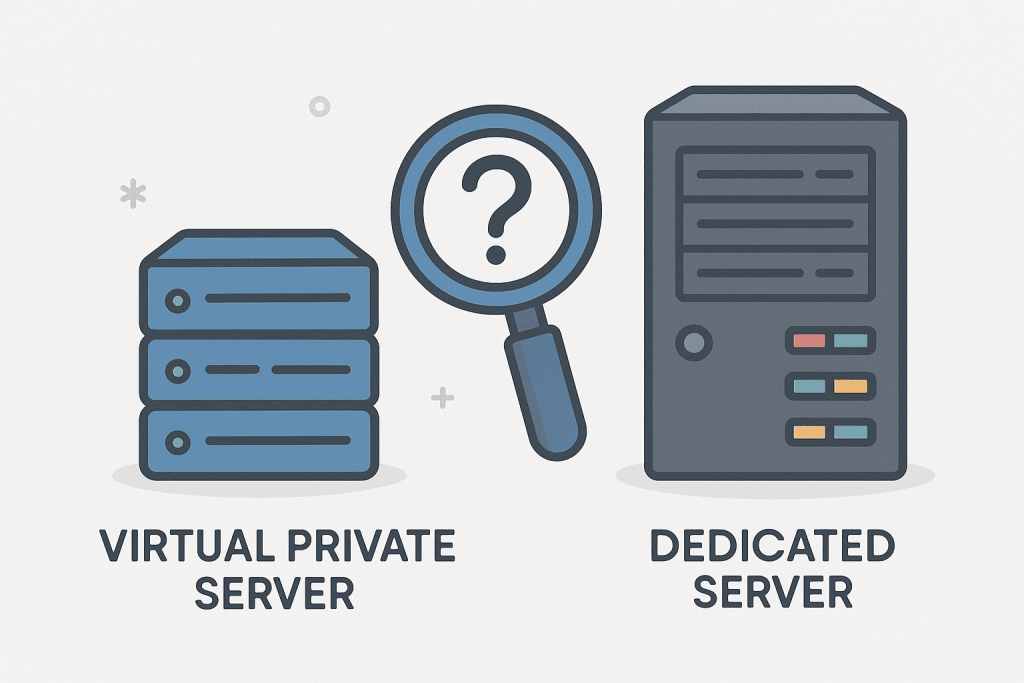
Today’s hosting industry offers a wide range of solutions for businesses and personal projects — from regular shared hosting to virtual private servers (VPS) and dedicated servers. However, there are many myths and stereotypes surrounding these services that prevent users from choosing the best option. In this article, we’ll look at the most common misconceptions about VPS and dedicated servers, explain where they are used, and help you better understand the benefits of these solutions.
Myths About VPS
Myth 1: “VPS is only for experienced administrators”
It is a common belief that managing a virtual server is complicated and only suitable for system administrators. In reality, modern providers offer user-friendly control panels (ISPmanager, Plesk, HestiaCP, and others) that make server management much easier, even for beginners. Such interfaces allow you to quickly set up a web server, databases, and mail services without deep knowledge of the command line. For more complex tasks, you can always rely on technical support or ready-made guides.
Myth 2: “VPS is too expensive for small projects”
Another stereotype is that renting a VPS costs significantly more than shared hosting. But many providers offer entry-level plans starting at just a few dollars per month. Such VPS solutions are great for blogs, corporate websites, or small online stores and often provide higher performance than shared hosting. What’s more, as your business grows, you can easily scale up the configuration without moving to a dedicated server.
Myth 3: “VPS is just an upgraded hosting”
With shared hosting, one server’s resources are divided among multiple clients, and users have no access to system settings. With VPS, you get an isolated environment with root access, the ability to install any software, configure a firewall, and run custom scripts. It’s not just an “upgraded” hosting plan — it’s a full-fledged virtual server with guaranteed dedicated resources.
Myth 4: “Virtual servers are unsafe”
Some think that because VPSs share the same physical hardware, they are vulnerable to attacks from neighboring users. In fact, modern hypervisors ensure strict isolation of resources. The main risks usually come from weak passwords, outdated software, or misconfigured firewalls. VPS security largely depends on proper administration and regular updates.
Myth 5: “Migrating to VPS is difficult”
Moving from shared hosting to a VPS may seem complicated. However, most providers offer tools for automated file and database migration, and popular CMS platforms have plugins for creating backups and restoring them on a new server. This means migration can often be completed without significant downtime.
Myth 6: “VPS is only for Linux”
It’s true that VPSs were historically based on Linux, but today it’s just as easy to order a Windows server with RDP access. This is important for companies that use specialized software requiring a Windows environment, such as 1C or certain CRM systems.
Myth 7: “VPS is hard to scale”
Some fear that as traffic grows, they’ll have to switch immediately to an expensive dedicated server. In reality, modern cloud platforms allow you to add resources — memory, CPU cores, disk space — in just a few clicks, paying only for what you use.
Where VPS Is Used
Virtual servers are widely used for projects of different sizes. They are ideal for online stores with moderate traffic, regional portals, CRM systems, mail services, and corporate intranets. VPSs are also popular for hosting websites, games, VPN services, testing environments, cloud storage, databases, and backup systems. Thanks to their flexibility and affordability, VPS has become the “golden mean” between shared and dedicated hosting.
Myths About Dedicated Servers
Myth 1: “Dedicated servers are very expensive”
Many believe that renting a physical server costs tens of thousands per month. In reality, prices have dropped significantly in recent years, and a wide variety of plans make it possible to find the right configuration for almost any project. The advantages of stability and security often outweigh the costs.
Myth 2: “Dedicated servers are only for large corporations”
The stereotype that only enterprises need dedicated servers is outdated. Small businesses also face increasing demands for performance, security, and reliability. Even smaller online stores or development studios can benefit from dedicated resources, ensuring consistent speed and data protection.
Myth 3: “They are only needed for heavily loaded websites”
While dedicated servers do provide plenty of power, they aren’t limited to huge portals. Even smaller projects with moderate traffic can benefit from stability and scalability. A company may, for instance, host multiple sites, CRM systems, and backups on one dedicated server.
Myth 4: “Managing a dedicated server requires professional skills”
Another misconception is that you need deep admin knowledge to run a physical server. In reality, most hosting providers offer managed services, where specialists set up the system, monitor its performance, apply updates, and ensure security. This allows clients to focus on business tasks instead of server maintenance.
Myth 5: “Dedicated servers are unnecessary — everything can be done in the cloud”
It may seem that cloud platforms have completely replaced physical servers, but that’s not true. Clouds are convenient for fast deployment and scaling, but they don’t always provide the same level of control, performance, or security as dedicated servers. For projects with strict compliance requirements, complex infrastructure, or heavy permanent workloads, a dedicated server remains the best solution.
Myth 6: “Dedicated servers guarantee 100% uptime”
Owning a server doesn’t mean absolute reliability. Uptime depends on network infrastructure, power redundancy, and provider support. It’s important to check the SLA when ordering. Backup systems improve availability, but they don’t eliminate downtime completely.
Myth 7: “Dedicated servers have excess power and aren’t cost-effective”
Some worry that server resources may go unused. But this is simply a matter of choosing the right configuration. Providers can help select the best fit for your needs and upgrade components later if necessary.
Where Dedicated Servers Are Used
Dedicated servers are often chosen for projects with high requirements for performance and security. They’re perfect for large online stores, news portals, and online communities that demand guaranteed resources and flexible customization. They are widely used for business applications (CRM, ERP, accounting systems), game hosting, virtualization, building private clouds, and storing large volumes of data. Dedicated servers are also a strong choice for streaming platforms, big data analytics, AI workloads, and corporate email systems, where full control and encryption are crucial.
Key Points to Remember
In today’s hosting market, it’s essential to separate facts from stereotypes. VPS solutions have proven themselves as flexible and affordable options for websites, online stores, CRM systems, mail platforms, and gaming servers. Myths about complexity, high costs, or weak security have been debunked in practice: modern control panels and support simplify administration, pricing is accessible even for small businesses, and proper configuration ensures high security.
Dedicated servers, meanwhile, are not reserved for large corporations. They’re ideal for projects that require full control over resources, flexible configurations, stability, and compliance with strict security standards. Falling prices and the availability of managed services make dedicated servers accessible to a wide range of companies. Ultimately, the choice between VPS and dedicated servers should depend on the specific needs of your project — and that’s what ensures the most effective solution.

Leave a Reply